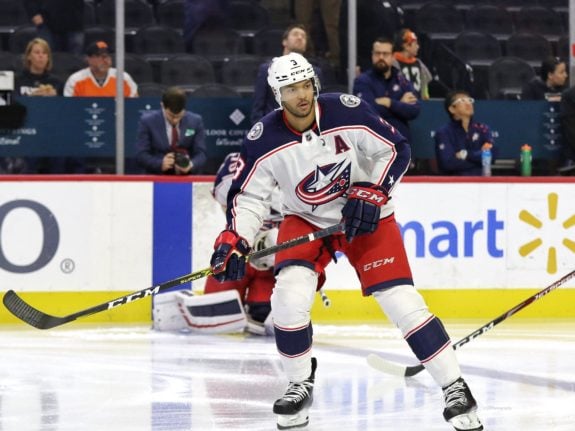All of the attention in Columbus Blue Jackets land these days has focused on the power play or their lack thereof. Things have been so tense in these last few days that it led head coach John Tortorella to defend his coach Brad Larsen. You can listen to the full interview below where Tortorella says that the blame should fall directly on him for their struggles.
Let’s be honest. This topic has been beaten into the ground and then some. It’s tiresome. It’s weighing on everyone, the coaches, the players and the fans. It is the source of incredible frustration.
Although the power play did get on the board Wednesday night thanks to a Zach Werenski goal, that was all they could muster for goals all night against an Edmonton Oilers team that dominated them. It got that way thanks in large part to penalties and the Oilers converting on their chances.
That’s where we need to focus our attention on. A big reason for the Blue Jackets 5-5-2 start is that their once dominant penalty kill has let them down. A close look at the early numbers and you’ll see why it’s a scary thing for this team.

Penalty Killing Troubles
Let’s turn the page back to last season just for a second to give you some perspective. In the midst of all the drama the Blue Jackets had while playing out their season, their penalty kill was one of the driving forces behind their run to the playoffs. They finished second in the NHL on the penalty kill (85.0%) while allowing just 30 power-play goals against (fewest in the NHL.) Anytime the team needed momentum, their penalty kill usually delivered.
At least 12 games into this new season, the penalty kill has experienced a sharp decline.
The Oilers scored once on their power play and had a second one go in just after a power play expired. On Saturday in Philadelphia, the Flyers scored two power-play goals on their way to a 7-4 victory.
For the season, opponents have scored nine times with the man advantage against the Blue Jackets in just 37 attempts. That’s a successful kill rate of 75.7%, almost a full 10 points lower than last season. This is a huge problem for a team that doesn’t have the same margin of error that they’ve had in past seasons.
In fact, opponents have been able to score multiple power-play goals in the same game against the Blue Jackets three times already this season. They are on pace to allow over 60 power-play goals. The question we need to consider here is why. What has changed so much from last season that we’re seeing a significant drop?
In my mind, a couple of things stand out.
- First, Josh Anderson is just getting back into the swing of things. The Blue Jackets have missed his presence, but especially on the penalty kill. His return will help get the rotation back to normal so I would expect better results overall as we move along.
- Second, per Nat Stat Trick, Alexander Wennberg has been on the ice for six of the nine goals against on the penalty kill in just 18 minutes of ice time. His xGA is 1.71. His on-ice save percentage is just 53.8% by his goalies. This is an area that is due for correction for sure, but it is contributing to these early results.
- Next, I don’t think there’s enough attention to detail being placed by the Blue Jackets. That 1-0 goal in the Edmonton game is a great play by goaltender Mike Smith, but it showed the Blue Jackets were asleep at the wheel. You can’t let that pass go through like that. Had the Blue Jackets been in the right position, that goal doesn’t happen. Instead, it propelled the Oilers to an easy win.
- Finally, the two players with the most ice time on the kill (Seth Jones and Zach Werenski) each have more to give. Both have been on the ice for five of the nine goals against. These two have to be engine that drives this bus. When things are going right, they are making impact plays whether it’s being disruptive to opponents or making great plays with the puck. There’s not enough coming from this top pair. They must start playing to their potential. Inconsistency will be more noticeable this season.

The one thing that hasn’t changed is the amount of penalties the Blue Jackets have taken. They average just seven minutes of penalties per game while being short just 37 times, each are in the top-10 for lowest in their respective category. The difference is the dramatic fall of the kill success rate. If the Blue Jackets hope to get back to some winning ways, they need to make their penalty kill a treat and not a trick. So far, it’s been nothing but tricks and a huge momentum boost for opponents.
So while the power play has taken its share of heat, the penalty kill is just as guilty, even more so given the success the Blue Jackets had last season. While I do expect this area to get better, it needs to happen sooner rather than later if they wish to stay in the race.